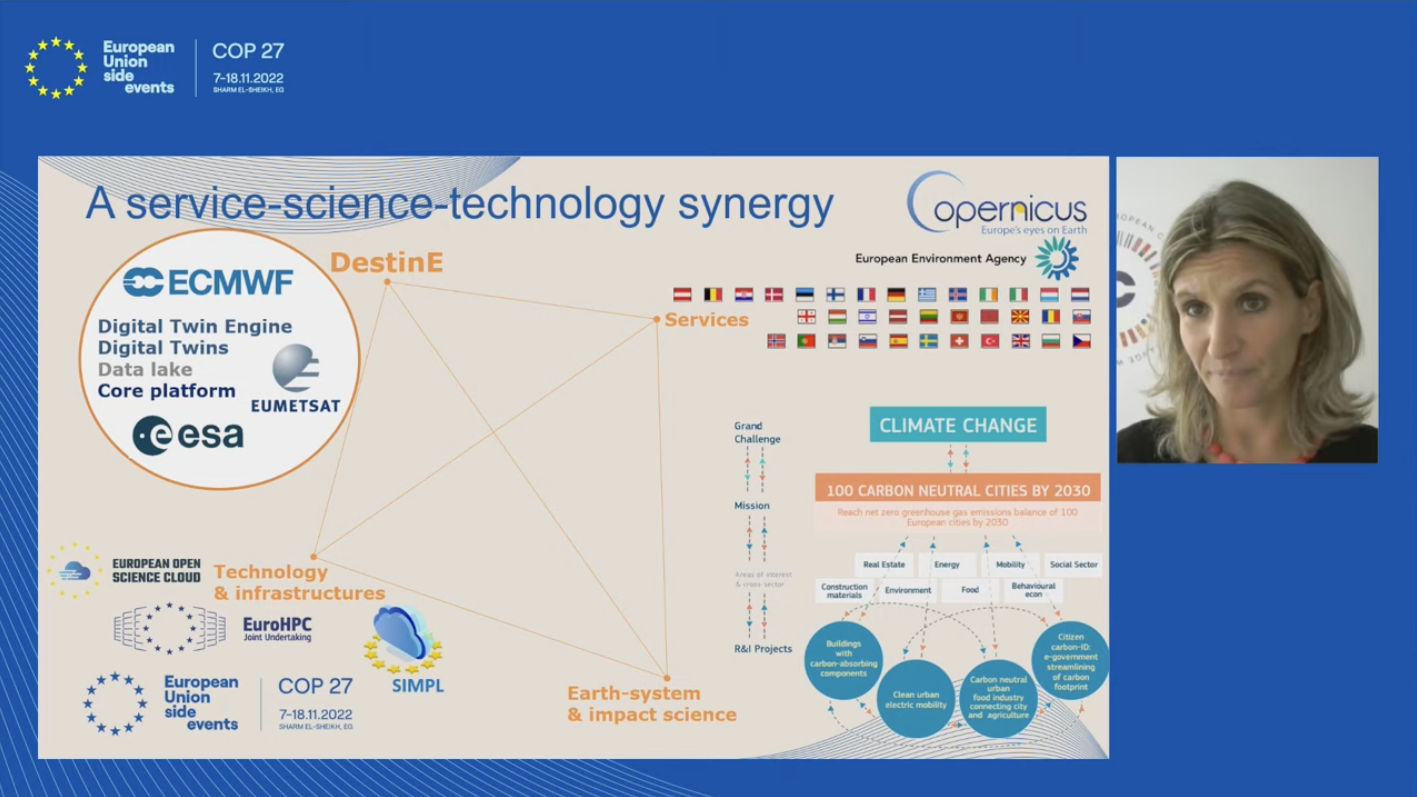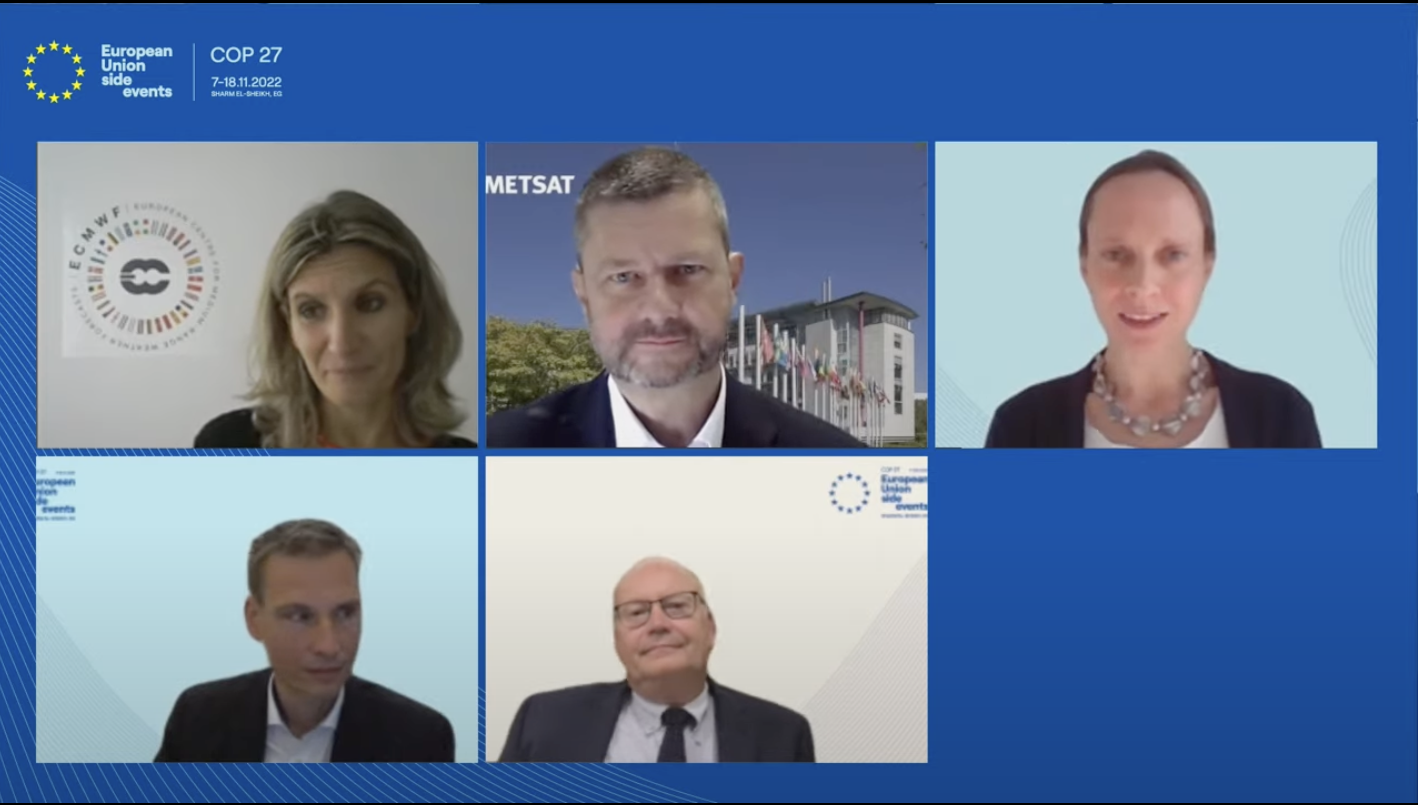Destination Earth at COP27: how the digital twin will support a greener future

The European Union has presented its ambitious initiative to create a digital twin of the Earth system, Destination Earth, during the United Nations Framework Convention on Climate Change (UNFCC) 27th Conference of the Parties (COP27). The online event, hosted by the EU Commission’s Directorate-General for the digital age (DG CNECT) and the Directorate-General for space and defence (DG DEFIS) featured representatives of the three entities in charge of implementing the programme, the European Centre for Medium-Range Weather Forecasts (ECMWF), the European Space Agency (ESA) and the European Organisation for the Exploitation of Meteorological Satellites (EUMETSAT).
In the context of climate change adaptation and Europe’s green deal, Destination Earth (DestinE) aims at delivering a digital twin or replica of the Earth system to support decision making and research efforts.
This digital replica of the Earth will provide a holistic view of the Earth system leading to new levels of information quality, making the link between climate change and how it impacts society. DestinE will rely on the fusion of huge volumes of observations and high resolution simulations, performed using some of Europe’s most powerful high-performance computing and data handling infrastructures.
This is, in summary, how Irina Sandu, Science Lead for Destination Earth at ECMWF, described the Digital Twin of Earth being developed in DestinE and the ECMWF contribution to the initiative, during an EU side event at COP27.
The session “Destination Earth: Earth’s digital twin to support greener policies for a greener future” on Thursday 10 November was part of the European Union’s programme of side events at COP27 and was chaired by Elisabeth Hamdouch, Deputy Head of Unit of the Earth Observation Unit at DG DEFIS and Tobias Wiesenthal, Deputy Head of Unit at the Open Science and Digital Modelling department of DG CNECT.
Watch the session in full
Enhanced prediction capabilities to help tackle the climate challenges
DestinE is implemented by ECMWF, ESA, and EUMETSAT and builds on the collective European expertise in numerical weather prediction, observations and HPC and data handling capabilities, as well as supporting user’s needs. This knowledge feeds on the experience of the three institutions, of National Meteorological and Hydrological Services and on European programmes such as Copernicus.
During the first phases of the programme, several thematic digital twins will be developed. In the long term, these will be merged into one single digital twin of the Earth system. ECMWF is responsible for delivering the first two high priority digital twins, on weather extremes and climate change adaptation, as well as the digital twin engine (DTE), the software infrastructure behind DestinE’s digital twins. The data will be stored and managed by EUMETSAT’s Data Lake and the users will access through the Core Platform implemented by ESA.
Irina Sandu presented to the audience the key principles of the digital twins that ECMWF is entrusted to deliver in the context of DestinE.
DestinE digital twins will rely on the fusion of an extremely large number of observations and simulations at higher resolution levels.
A specific focus for DestinE’s Digital Twins is also to bring together in the same modelling chain the components of the entire Earth system, namely both the physical processes as current models do, and the modelling of aspects relevant for important impact sectors like air pollution, flooding or wildfires.
This will allow the production of weather, climate and impact-sector related information at scales where climate change and extreme weathers are perceived and matter, to create the best possible assessment in support of decision-making for the benefit of society.
DestinE’s Digital Twin of Earth will create an interactive information system, giving users the ability to interact with workflows, data and models, and to thus make the best possible use of the vast information that the individual digital twins will deliver.
“As the data volumes involved will be unprecedented, DestinE will create a shift in paradigm where we move away from bringing the data to the users to bringing the users to the data,” said Irina Sandu.
Near surface temperature (colours) and winds (white shading) from ECMWF IFS 4 km. simulations. Credits: nextGEMS, Nikolay Koldunov (AWI), Thomas Rackow (ECMWF)
Near surface temperature (colours) and winds (white shading) from ECMWF IFS 4 km. simulations. Credits: nextGEMS, Nikolay Koldunov (AWI), Thomas Rackow (ECMWF)
The Science Lead for Destination Earth at ECMWF presented this animation at a resolution of 4 kilometres, produced in the EU Horizon 2020 project nextGEMS, which builds prototypes of the high resolution (storm and eddy resolving) Earth system models that will be used for DestinE’s climate adaptation digital twin. “This animation illustrates why we need accurate information not only at global scale but also at a regional, national and even city level - you can see sharp gradients in temperature in this case for different parts of Europe and even sharp variations from one country to the next,“ said Irina Sandu.
The first two high priority digital twins
The first digital twin ECMWF will deliver will focus on extreme weather event prediction on time spans of a few days ahead. It will provide information both globally at km-scale, in a continuous mode, and regionally at sub-km scale in an on-demand mode.
The global continuous component will build on ECMWF’s Integrated Forecasting System.
The on-demand component will be developed by a large pan-European partnership led by MétéoFrance.
This will provide an interactive European monitoring and prediction framework at sub-km resolution, from continental to city scales providing insights on meteorological, hydrological and air quality extremes.
The second high-priority digital twin ECMWF will deliver is the Climate Change Adaptation Digital Twin. This digital twin will deliver global multi-decadal simulations at 5 km and will be developed by a strong partnership led by the CSC – IT Science Centre in Finland.
Pan-European synergies between science, technology and the services
The success of DestinE depends on strong synergies and partnerships with existing national and European numerical weather prediction, environmental and climate services. It also relies on strong partnerships within the Earth system modelling and the impact science sectors, because the digital twins depend both on existing models and a new generation of much higher resolution models, being developed thanks to European research and development funding opportunities like Horizon 2020 and Horizon Europe.
Finally, the success of DestinE relies on strong synergies with the technology and high-performance computing sectors. “The fact that we can even envisage running Digital Twins is thanks to the advances in technology and to the partnership with initiatives like EuroHPC Joint Undertaking. Several of the EuroHPC JU HPC facilities will serve to run the digital twins' complex operations,” said Irina Sandu.

A moment of Irina Sandu's presentation
A moment of Irina Sandu's presentation
ECMWF has also awarded the invitation to tenders for DestinE’s visualisation and immersive technologies to Italy’s Exprivia, along with other leaders of the Italian IT sector, and established a number of technological partnerships with key players of the European HPC ecosystem such as ETP4HPC and Italy’s Cineca.
The enhanced observation, computing and simulation capabilities generated by Destination Earth will also benefit the existing services such as the National Meteorological and Hydrological services and the Copernicus services, contributing to improving the predictive capabilities in Europe and beyond, with the common goal of achieving the European greenhouse gas reduction and green transformation objectives and the United Nation’s sustainable development goals.
Lively interest among the audience
Together with Irina Sandu, at the COP27 side event Nick Hanowski, Head of the Mission Management & Ground Segment Department at ESA, described the features and progress of DestinE’s Service platform, and Lothar Wolf, Destination Earth Programme Manager at EUMETSAT, described the innovative integrated data management concept of the data lake.
The session triggered considerable interest with many questions from the audience. One of the viewers asked what Irina Sandu meant by bringing the users to the data. She explained that, given the gigantic data volumes Destination Earth envisions, users won’t be able to interact with the data as is currently done. "Imagine splitting Earth horizontally in cubes of 1 km. The amounts of information are enormous, so that data cannot be just downloaded and processed by the user. The Copernicus Climate Change and Atmosphere Monitoring Services are partly doing this with the Climate and Atmosphere Data Stores, but DestinE plans to do this on a larger scale."
Users also wanted to know the advantages that DestinE will bring and what kind of data is needed to create a digital twin.
“ECMWF receives 800,000,000 observations daily from satellites and in situ sources but with the current technology we can only use a small portion of all of that data. Increasing the resolution of the prediction systems underpinning the digital twins will allow better use of this data, in addition to the use of new datasets.” added Irina Sandu.

A moment of the panel featuring all participants. (Left to right, top-bottom: Irina Sandu (ECMWF), Lothar Wolf (EUMETSAT), Elisabeth Hamdouch, Deputy Head of Unit of the Earth Observation Unit at DG DEFIS, Tobias Wiesenthal, Deputy Head of Unit at the Open Science and Digital Modelling department of DG CNECT, Nick Hanowski, Head of the Mission Management & Ground Segment Department at ESA
A moment of the panel featuring all participants. (Left to right, top-bottom: Irina Sandu (ECMWF), Lothar Wolf (EUMETSAT), Elisabeth Hamdouch, Deputy Head of Unit of the Earth Observation Unit at DG DEFIS, Tobias Wiesenthal, Deputy Head of Unit at the Open Science and Digital Modelling department of DG CNECT, Nick Hanowski, Head of the Mission Management & Ground Segment Department at ESA
Destination Earth is a European Union funded initiative launched in 2022, with the aim to build a digital replica of the Earth system by 2030. The initiative is being jointly implemented by three entrusted entities: the European Centre for Medium-Range Weather Forecasts (ECMWF) responsible for the creation of the first two ‘digital twins’ and the ‘Digital Twin Engine’, the European Space Agency (ESA) responsible for building the ‘Core Service Platform’, and the European Organisation for the Exploitation of Meteorological Satellites (EUMETSAT), responsible for the creation of the ‘Data Lake’.
We acknowledge the EuroHPC Joint Undertaking for awarding this project strategic access to the EuroHPC supercomputers LUMI, hosted by CSC (Finland) and the LUMI consortium, Marenostrum5, hosted by BSC (Spain) Leonardo, hosted by Cineca (Italy) and MeluXina, hosted by LuxProvide (Luxembourg) through a EuroHPC Special Access call.
More information about Destination Earth is on the Destination Earth website and the EU Commission website.
For more information about ECMWF’s role visit ecmwf.int/DestinE
For any questions related to the role of ECMWF in Destination Earth, please use the following email links:
Press and Communications enquiries
Further reading:
ECMWF Destination Earth webpage
Shaping Europe's Digital Future
